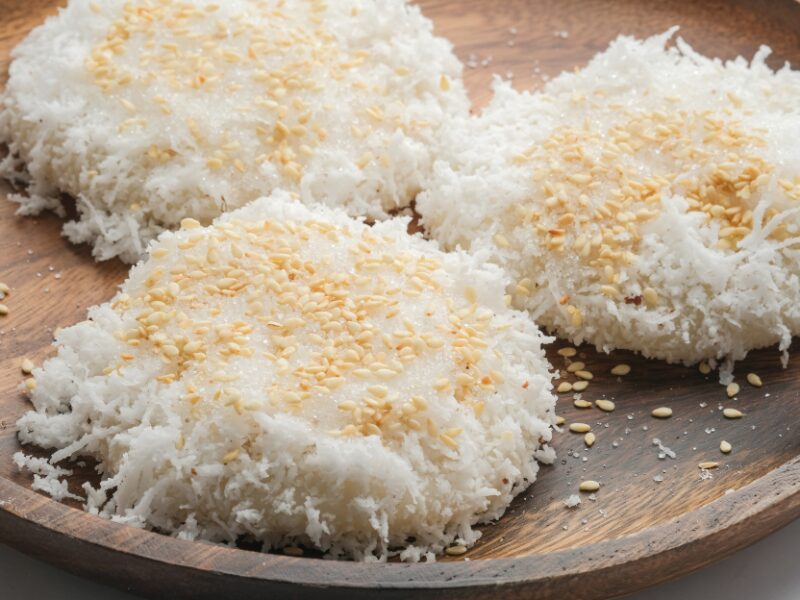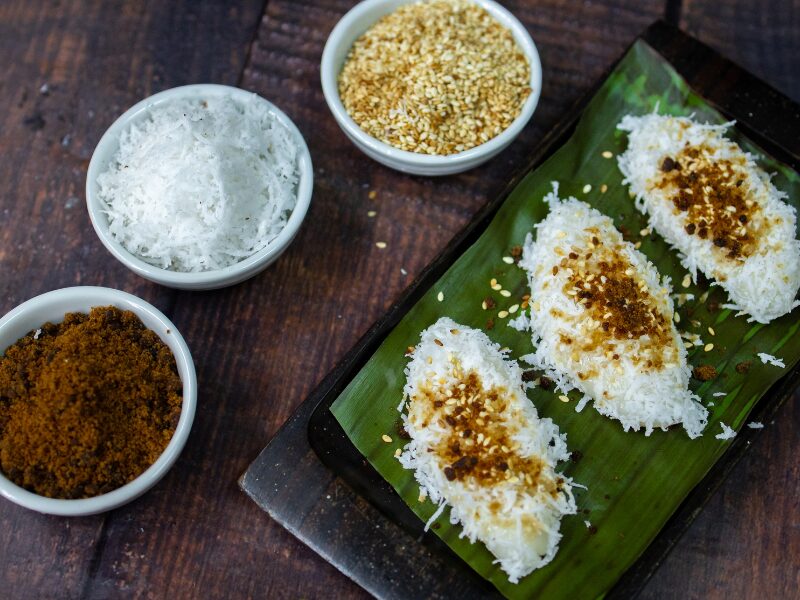Palitaw Recipe
If you want a quick and easy-to-make treat, palitaw is the key. But if you don’t know where to start, we got your back. This palitaw recipe features everything you need to know, from how to make it to the palitaw ingredients you need.
What Is Palitaw?
Palitaw refers to a sweet flat rice cake Filipinos enjoy as a snack or dessert.
Traditionally, people use grounded or pounded sticky rice to make this kakanin (rice cake). People soak glutinous rice in water overnight. They then process it into a soft dough through grinding. Next, they form the dough into thin patties, cook them in boiling water, and coat them with grated coconut, sugar, and toasted sesame seeds.
However, people switched to the easier option when packaged rice flour became readily available. Nowadays, people make palitaw by simply mixing rice flour and water to form a dough. They then divide it into small pieces, mold them into balls, and flatten them.
Next, they cook the flattened dough in boiling water until they float. For this reason, people call the treat palitaw― derived from the word “litaw”, which means “to float or to surface”.
Why People Love Palitaw

While people often enjoy palitaw as an everyday snack or merienda, you can also see it on holidays like Christmas and New Year’s Eve.
For one, Filipinos love palitaw recipes because they believe that serving and eating something sweet on New Year’s Eve brings a bountiful year ahead (the palitaw surfacing symbolizes luck floating to the surface). Palitaw is also sticky, which means it can help their loved ones stay close.
Second, people love palitaw recipes because the treats are delicious and flexible. Unlike baked desserts, where you have to be extremely precise, palitaw ingredients give you room for experiments. Want palitaw with cheese? Roll them in cheese instead of coconut or both.
Want to make flavored palitaw? Add ube extract or your favorite flavor, like vanilla, chocolate, or pandan, to the dough. The mouthwatering possibilities are endless.
Additionally, palitaw recipes are so easy to make. All you need are two basic palitaw ingredients for the dough, no oven for baking required. You can also make a big batch in just under an hour, making it perfect for parties and get-togethers.
Palitaw Cooking Tips

- Use the right glutinous rice flour and water ratio for the best texture. Not putting enough water makes the treat hard to chew. On the other hand, too much liquid makes it hard to shape the dough.
- Aim for consistency like a soft, pliable putty. The dough must be moist but not overly wet.
- Use a tiny scoop to divide the dough into uniform sizes. Then, use the palm of your hands to roll each portion into a ball.
- If the dough becomes sticky while shaping, wet your hands in between the process.
- Use a slotted spoon to remove the patties when they rise to the surface. Do this immediately to prevent the palitaw ingredients from overcooking.
- Let the patties cool. They should be cool enough to touch. Once ready, roll them in grated coconut since the coconut sticks better when the patties are warm.
- Sprinkle sugar and sesame only when ready to serve. Sugar easily dissolves over time. As an alternative, serve the sugar and sesame on the side.
How to Store Palitaw
- Avoid keeping it for too long at room temperature. The grated coconut will spoil quickly, especially in hot weather.
- If you want to store the treat, coat the patties with grated coconut, not sesame and sugar. Put the palitaw in an airtight container and put it in the fridge. You can keep it there for one to two days. We suggest this storage period because the texture of the palitaw ingredients changes when cold.
What to Serve With Palitaw

Take your palitaw to the next level by serving them with the right dishes. Here are some ideas:
Grilled or Roasted Meat
Palitaw pairs well with the rich, savory flavors of grilled or roasted meat, such as pork barbecue, chicken inasal (grilled chicken), lechon paksiw (pork vinegar stew), or lechon kawali (crispy pork belly).
Seafood
You can also serve palitaw with seafood like squid, milkfish, tilapia, or buttered shrimp. The savory, rich seafood contrasts nicely with palitaw’s sweetness. Serve the seafood with a vinegar or soy sauce dip for that extra oomph.
Vegetables
A vegetable dish like chopsuey or pinakbet goes well with palitaw, thanks to its various textures and flavors. The dish also adds a healthy component to the meal.
Biko
Serve palitaw with another glutinous rice dessert, biko. It is sticky, sweet, and topped with rich latik (coconut curd). Its creamy sweetness goes well with the lighter sweetness of palitaw.
Halo-Halo
This beloved Filipino summer dessert also pairs with palitaw well. With delicious ingredients like sweet beans, fruits, leche flan, and ube (purple yam), halo-halo is a refreshing follow-up to the chewy treat.
Salabat (Ginger Tea)
A warm cup of ginger tea contrasts well with the sweet and chewy palitaw. The soothing and mildly spicy tea makes the meal more exciting.
Coffee
Great news to the coffee lovers out there. Palitaw and coffee are a great pair, especially for those who want a nice, filling breakfast or afternoon snack.
Coconut Juice
Since palitaw ingredients are rolled in grated coconut, it’s just fitting to serve it with a glass of coconut juice. As an alternative, you can serve it with a glass of buko pandan, a sweet pandan and coconut beverage.
Palitaw Recipe

Cuisine: Filipino
Prep Time: 10 minutes
Cook Time: 10 minutes
Total Time: 20 minutes
Servings: 6
Ingredients
¼ cup sesame seeds
½ cup sugar
1 cup grated mature coconut
2 cups glutinous rice flour
1 cup water
water for boiling
Instructions
- Combine water and glutinous rice flour to make a soft, pliable dough. Add some water if the dough cracks when flattened. On the other hand, add a tablespoon of glutinous rice flour at a time if the dough is too sticky or soft.
- Once you get the right consistency, portion the dough into uniform sizes. Then, shape each portion into a ball, about an inch in diameter.
- Next, flatten the balls to patties with a quarter-inch thickness by pressing them between your hands.
- Then, boil about five-inch deep of water in a pot over medium-high heat.
- Gently drop each patty into the boiling water. Avoid overcrowding the pot. Once the palitaw floats to the surface, remove them from the water with a slotted spoon and drain well.
- Roll the patties in grated coconut once they become cool enough to the touch. Lastly, sprinkle or roll them in sugar and sesame seeds.
- Enjoy your chewy, sticky, sweet palitaw!
Frequently Asked Questions
Palitaw is made of glutinous rice flour, water, sugar, grated mature coconut, and sesame seeds.
The other name for palitaw is “dila dila”. “Dila” means tongue. This is another name for palitaw because the patties resemble tongues.
The difference between palitaw and mochi and their shapes and methods of cooking. Palitaw are flat patties, while mochi look like balls. Additionally, palitaw are boiled in water until they rise to the top, while mochi are baked.
Conclusion
Made with glutinous rice flour, sugar, grated coconut, and sesame seeds, palitaw is a Filipino dessert worth every coin in your purse. Soft, chewy, and gluten-free, you can enjoy it as a snack or dessert. So, what are you waiting for? Grab your kitchen tools and equipment and start following this delectable palitaw recipe now!
About HICAPS
Over the years, HICAPS has helped bakers and businesses make delicious products by offering ingredients like ChiffonAide Cake Oil, Magic Whizk Whipping Cream, Red Velvet Flavor Emulco, and Instabake Brownie Mix.
HICAPS also provides tools and resources to valued partners, such as the free “How to Increase Your Sales Amidst the Pandemic” E-book and free dealer locator that helps look for baking ingredients near me.
Want more free tips and tutorials? Follow us on Facebook at Hicaps Mktg. Corp. and on YouTube at HicapsTV. Want to be one of our valued partners? Fill this form out. Looking forward to talking to you soon!







